A Farewell to Venus, a Week of Waxing Moon Viewing, Jupiter Sports Shadow Spots, and then Enters the Evening Sky!

This inverted picture of the crescent Venus was taken by holding my smartphone over the eyepiece of my telescope at 9 pm on Thursday, May 21, 2020. The crescent was also visible in binoculars. If you have clear skies after sunset in the next several days, have a go!
Hello, Late-May Stargazers!
Here are your Astronomy Skylights for the week of May 24th, 2020 by Chris Vaughan. Feel free to pass this along to your friends and send me your comments, questions, and suggested topics. You can also follow me on Twitter as @astrogeoguy! Unless otherwise noted, all times are expressed in Eastern Time.
I can bring my Digital Starlab portable inflatable planetarium to your school or other daytime or evening event, or teach a session online. Contact me through AstroGeo.ca, and we’ll tour the Universe or the Earth’s interior together!
Comet SWAN is still bright enough to see with binoculars, especially if you live at a southerly latitude. Another, dimmer comet named PanSTARRS is nearly straight overhead during evenings, and it’s driving straight towards the Big Dipper’s bowl – making it easy to locate. Jupiter will host some moon shadow transits in the morning. The young crescent moon will join Mercury and Venus in the west after sunset on Sunday night, May 24. Each subsequent night Venus will sink out of sight, leaving Mercury to hold court in the west. Meanwhile, the waxing moon will offer delightful evening views all over the world this week. Here are your Skylights!
Bright Comets Update
As I mentioned last week, a comet named c/2020 F8 (SWAN) had become bright enough to see with binoculars – then it stalled. Its orbit is keeping it too low in the sky and too close to the sun for easy viewing by people living at mid-northerly latitudes. But folks at more southerly latitudes, or in the Southern Hemisphere, are getting good views of it.
In binoculars and backyard telescopes, it should look like a greenish fuzzy patch with a faint narrow tail that extends to the upper right (or celestial north). Comet SWAN is predicted to reach peak brightness around May 27 when it swings around the sun at perihelion.

This week, look for Comet SWAN sitting low in the northwestern sky after the sky darkens – at 9:30 pm local time. This week its orbit will take it east out of Perseus (the Hero) and close to the very bright star Capella on next Sunday night.
Another comet named c/2017 T2 (PanSTARRS) is bright enough to see in backyard telescopes. It is much better positioned for viewing. It’s right beside the Big Dipper, which sits overhead during the evening at this time of year. On Sunday night, May 24, the comet will be a fist’s diameter to the lower right of the bright star Dubhe. That star marks the outer rim of the dipper’s bowl. Over the next seven nights, the comet will travel towards Dubhe.
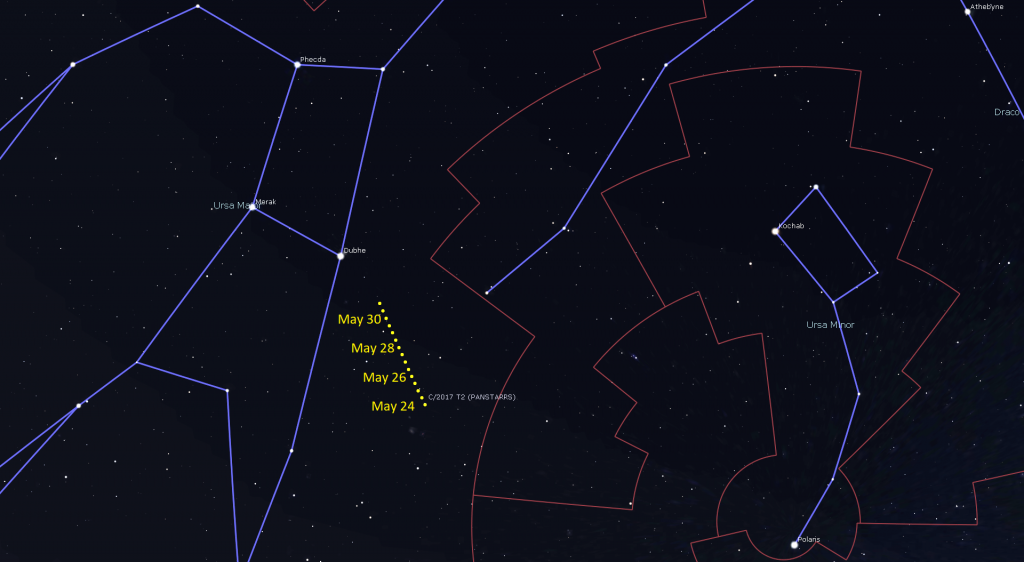
The Moon and Planets
This is the week of the lunar month when our natural satellite graces the evening sky all over the world – first as a delicate crescent, and then as a bright beacon lighting our way on late-evening outings. As the moon waxes this week, the sun is slowly rising over the moon’s eastern horizon – filling the moon with light from right to left, if you are viewing it from the Northern Hemisphere. (Southern Hemisphere observers have grown up seeing the moon upside-down and waxing from left to right!)
The curved line that separates the lit crescent of the moon from the dark remainder is called the terminator. A person standing anywhere along the terminator would see the sun cresting the lunar horizon. The almost-horizontal sunlight striking the moon’s terrain there produces long, black shadows from every crater rim, mountain, ridge, hill, or bump. The effect is especially dramatic and spectacular when seen through binoculars and telescopes of any size.
As the moon orbits Earth, the moon slowly rotates to keep the same near-side face pointed towards us. The angle formed by the sun, moon, and Earth increases all the while. As a result of that, the moon moves east across the sky – and sets later every night. The terminator shifts every night, too, inviting us to see new vistas every night.
Tonight (Sunday) look for the moon as a gorgeous slim crescent sitting in the lower part of the western sky after sunset. Very bright Venus will sit a fist’s diameter to the moon’s lower right. Much dimmer Mercury will occupy a position midway between the moon and Venus – making spotting that elusive planet very easy, especially at about 9:30 pm in your time zone.
Venus will be nearly 32 times brighter than Mercury. When viewed in a backyard telescope, Mercury will show a more than half-illuminated disk, while Venus will show a very slim crescent. This difference in illumination occurs because Venus is passing between Earth and the sun while Mercury a bit farther from Earth than the sun and off to one side of it. If you want to easily see the inner planets’ less-than-fully-illuminated disks, aim your telescope at them as soon as you can pick them out of the darkening sky. In a twilit sky, bright Venus’ out-of-round shape will be more apparent. And, when they are higher in the sky you’ll be viewing the planets more clearly – through less of Earth’s distorting atmosphere.
Venus and Mercury will remain in the western post-sunset sky after the moon moves eastward away from them. Venus is rapidly descending every evening as it decreases its angular separation from the sun. By the end of this week, Venus will be too close to the sun for viewing – ending a very long stint as the “Evening Star”. Meanwhile Mercury is climbing higher and increasing its separation from the sun – improving its visibility. Mercury’s location in the sky won’t change much this week, so check back on clear nights.
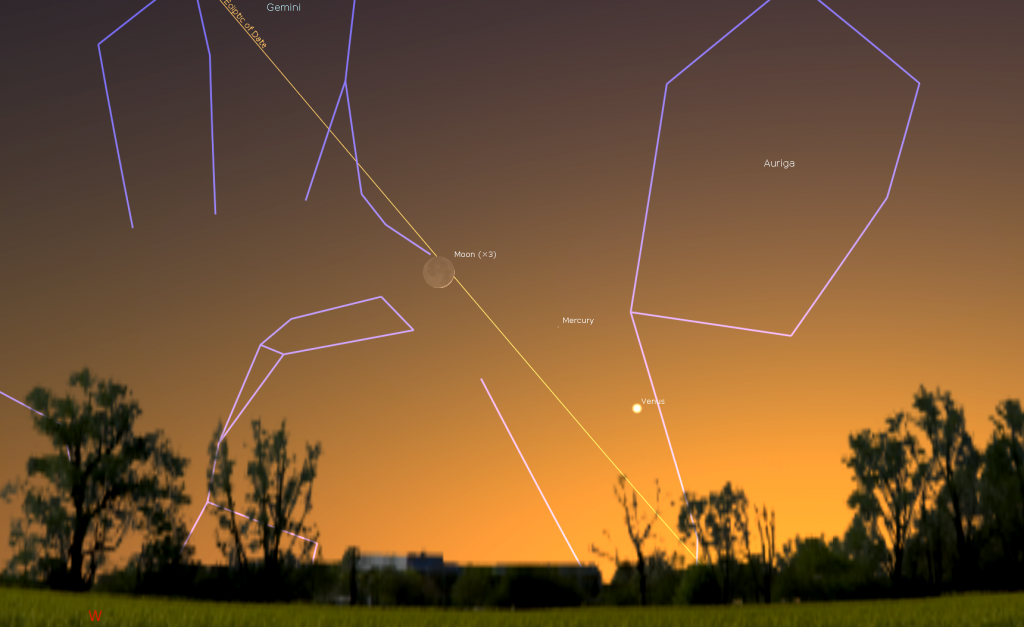
Sunday’s slim crescent moon might exhibit Earthshine – sunlight that has reflected off Earth and brightened the dark portions of the moon. You can watch for the effect on Monday evening, too.
On Monday night the slightly brighter crescent moon will sit between the twins of Gemini. And on Tuesday night, it will climb to sit off to the left (or celestial southeast) of the bright star Pollux, Gemini’s eastern twin. Note that Pollux is actually not a twin to the western brother, Castor. Pollux is somewhat brighter than Castor and shines with a warmer colour. (A telescope will show that Castor is actually composed of more than one star!)
On Wednesday evening the moon will pass close to the large open star cluster called the Beehive and Messier 44 (M44) in the constellation of Cancer (the Crab). The moon passes through, or close to, this cluster frequently because the Beehive is located only 1 degree north of the ecliptic – the imaginary circle around the sky that the sun, moon, and planets travel along. The moon will pass above (or north of) the cluster. M44 covers an area of sky as large as the moon. To see the cluster’s several dozen brightest stars, wait until the sky is dark (at about 9:30 pm local time) and then place the bright moon just above the field of view of your binoculars.
From Thursday to Saturday, the moon will travel through the constellation of Leo (the Lion). The moon will hop past the lion’s brightest star, white Regulus, from Thursday to Friday. The moon will reach its first quarter phase on Friday night at 11:30 pm Eastern Time (or Saturday at 3:30 Greenwich Mean Time). First quarter moons rise around noon and set at about midnight, so they are visible starting in the afternoon hours. The term “first quarter” refers not to the moon’s appearance, but the fact it has now completed one quarter of its orbit around Earth, counting from the last new moon.
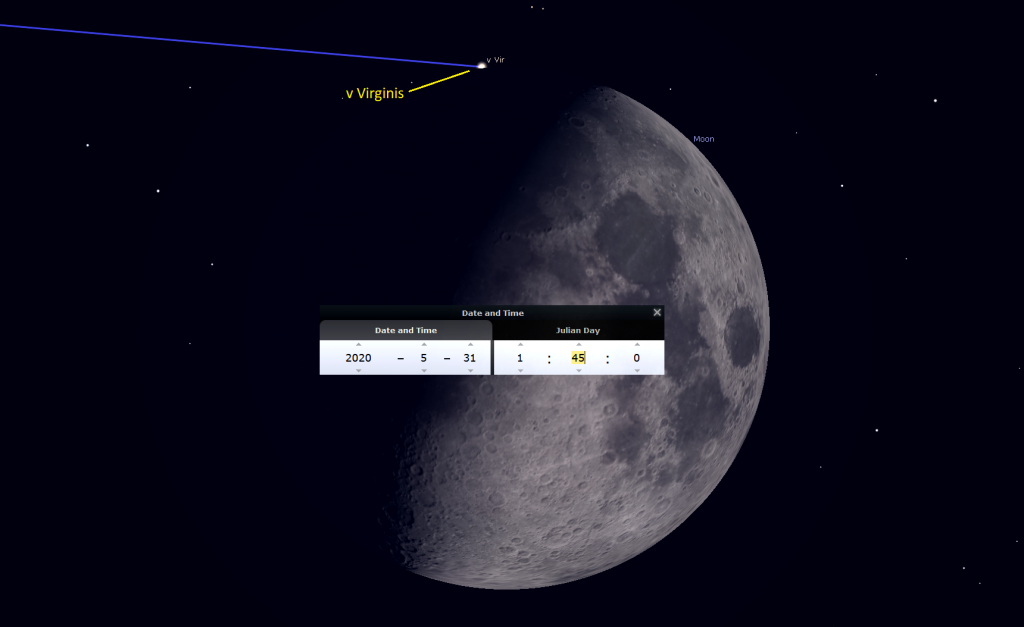
In the western sky early on Sunday morning, the northern edge of the moon will occult the medium-bright star in Virgo (the Maiden) known as v Virginis, or 3 Virginis. A 1:45 am EDT in the Great Lakes Region, the dark leading edge of the moon will pass over the star, causing it to wink out when viewed through binoculars or telescopes. At 2:10 am EDT, the star will re-appear from behind the lit edge of the moon. The event will be visible widely across the Americas, but the timing and duration of the occultation depends on your location – and in some areas, the moon will simply skim past the star without hiding it.
At the end of this week, Jupiter will begin to rise before midnight – signalling that our summer of planet viewing is about to arrive! In the wee hours of the night, the very bright, white planet might catch your eye through a southerly window. By dawn it will be sitting less than three fist diameters above the southern horizon before fading into the brightening sky.
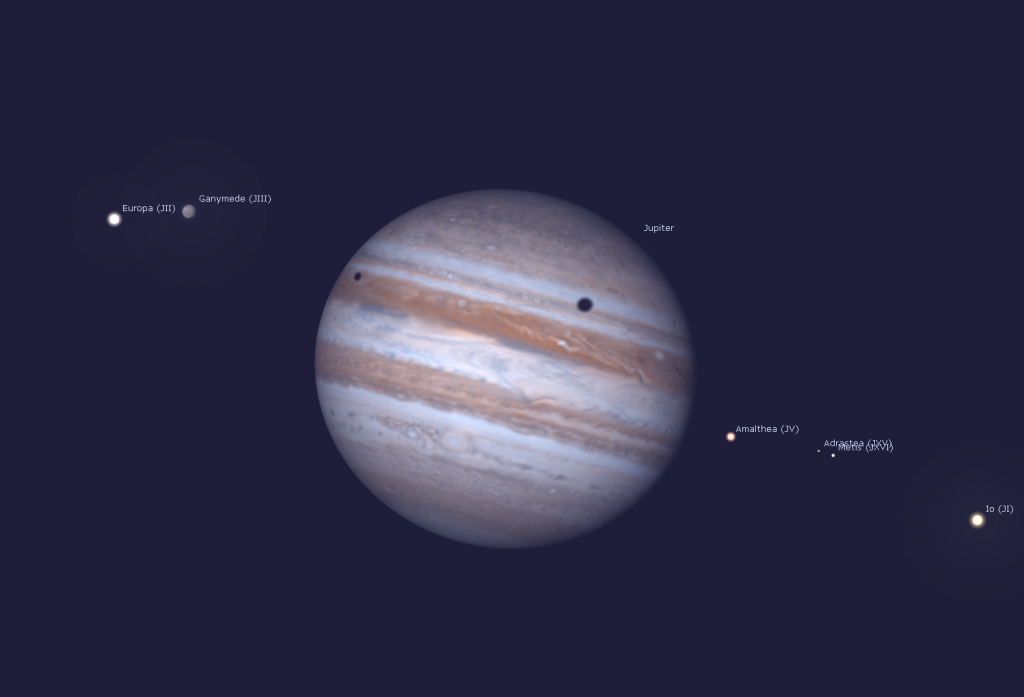
In the Eastern Time zone, Jupiter’s Great Red Spot will be crossing the planet’s disk before dawn on Monday morning, Wednesday morning, and Saturday morning. From time to time, the small round black shadows cast by Jupiter’s four Galilean moons become visible in amateur telescopes as they cross (or transit) the planet’s disk. On Thursday morning, observers in the Americas can see two of those shadows cross the northern hemisphere of Jupiter at the same time! At 4:48 am EDT, Europa’s smaller shadow will join Ganymede’s larger shadow already in transit. 64 minutes later Ganymede’s shadow will move off the planet at 5:52 am EDT, leaving Europa’s shadow to complete its crossing. The latter stages of the double shadow transit favor observers west of the Eastern Time Zone, where the sky will be darker. On Friday morning, Io’s shadow will accompany the Great Red Spot between 3:10 am and 5:25 am EDT.
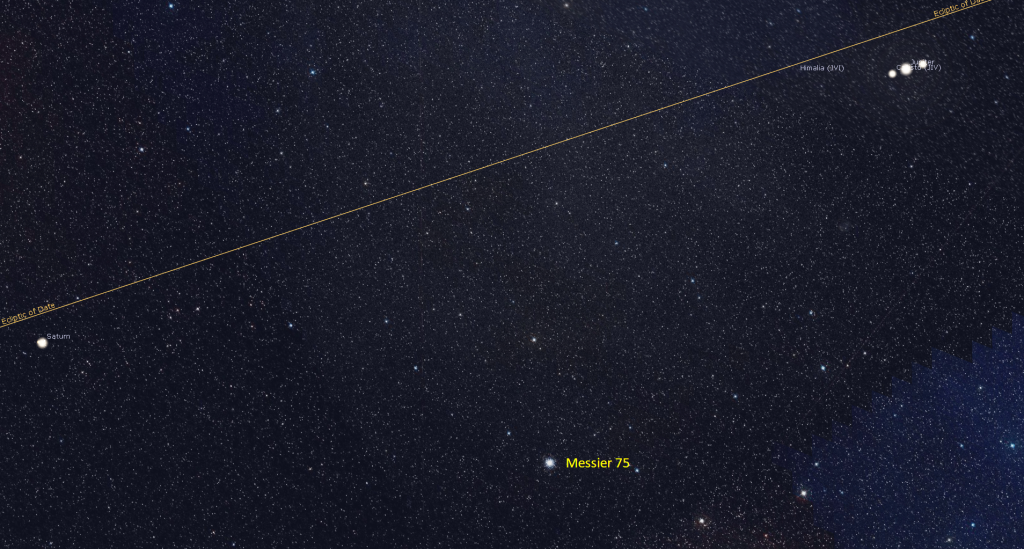
Saturn will be accompanying Jupiter in the sky all year long, but it will vanish into the twilight before brighter Jupiter. The yellow-tinted and somewhat dimmer planet will rise 15 minutes after Jupiter. Look for its fainter dot sitting less than a palm’s width to the lower left (or 4.75 degrees to the celestial east) of Jupiter. For about the next two weeks, the globular star cluster designated Messier 75 will be positioned below and between Saturn and Jupiter. Messier 75 shines with a visual magnitude of 9.2. In the hours before the sky begins to brighten, the cluster should be visible in binoculars and backyard telescopes as a small, fuzzy patch positioned approximately 1.5 finger widths below (or 1.5° to the celestial south of) the two bright planets.
Reddish Mars has been speeding eastward along the ecliptic, leaving the bright gas giants planets far behind. This week, Mars will be crossing Aquarius (the Water-Bearer). It will be rising after 2:15 am local time, and remaining visible until dawn, when it will be found about two fist diameters above the southeastern horizon. Mars is steadily increasing in disk size and brightness because Earth is travelling towards it.
Mars is going to pass close to much dimmer Neptune in a couple of weeks.
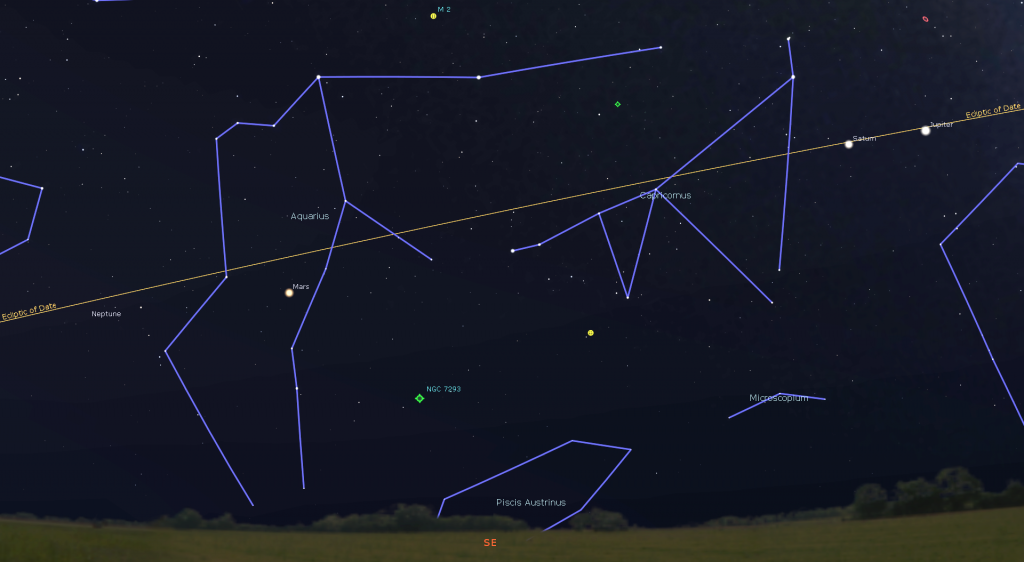
Public Astro-Themed Events
Due to the COVID-19 virus, in-person public star parties and lectures have been cancelled or postponed for the moment. Here are some Internet-based astro-themed activities.
On Wednesday, May 27 at 7:30 pm, RASC Toronto Centre will livestream their monthly Recreational Astronomy Night Meeting at https://www.youtube.com/rasctoronto/live. Talks include the Sky This Month (for June), how to share your astrophotos online, and the dance of Venus, the Moon, and the Sun. Details are here.
For one more week, our Insider’s Guide to the Galaxy online sessions will be hosted by Paul Owen, who is returning to talk about processing your astrophotos. I’ll be back in June. Details on this and the upcoming sessions are here.
Many astronomers are running broadcasts of the views through cameras attached to their telescopes while they describe the item and take questions. A search for the terms “star party” on YouTube and FaceBook should let you find live or pre-recorded sessions.
The Canadian organization Discover the Universe is offering astronomy broadcasts via their website here, and their YouTube channel here.
On many evenings, the University of Toronto’s Dunlap Institute is delivering live broadcasts. The streams can be watched live, or later on their YouTube channel here.
The Perimeter Institute in Waterloo, Ontario has a library of videos from their past public lectures. Their Lectures on Demand page is here.
Keep looking up, and enjoy the sky when you do. I love questions and requests. Send me some!